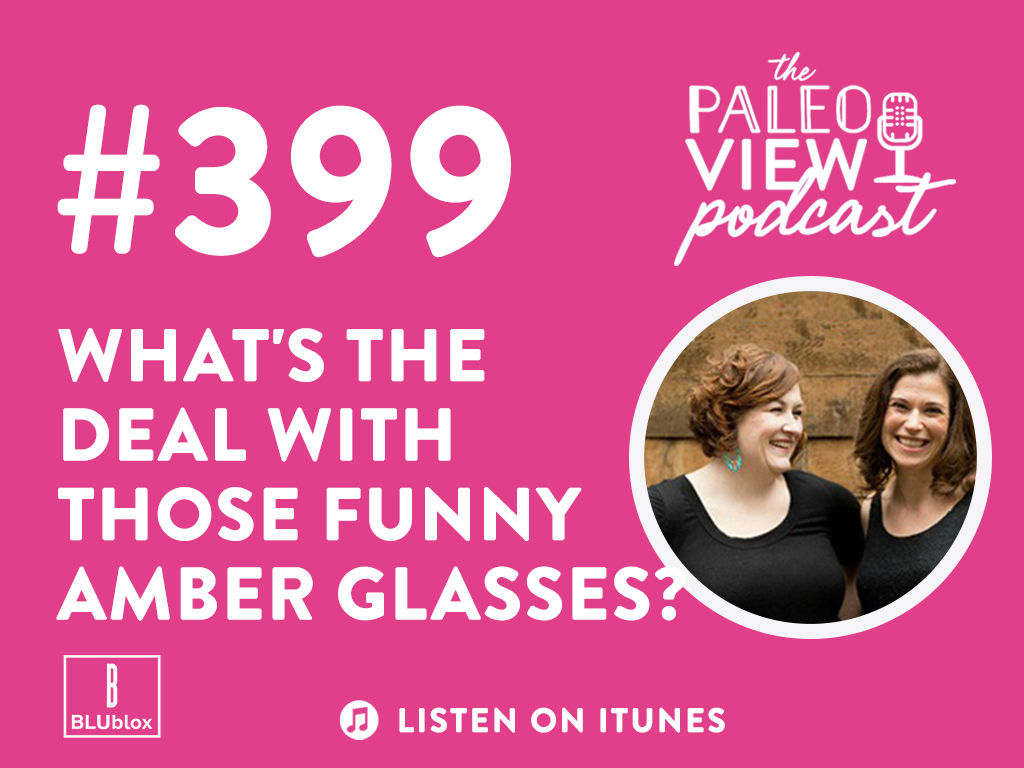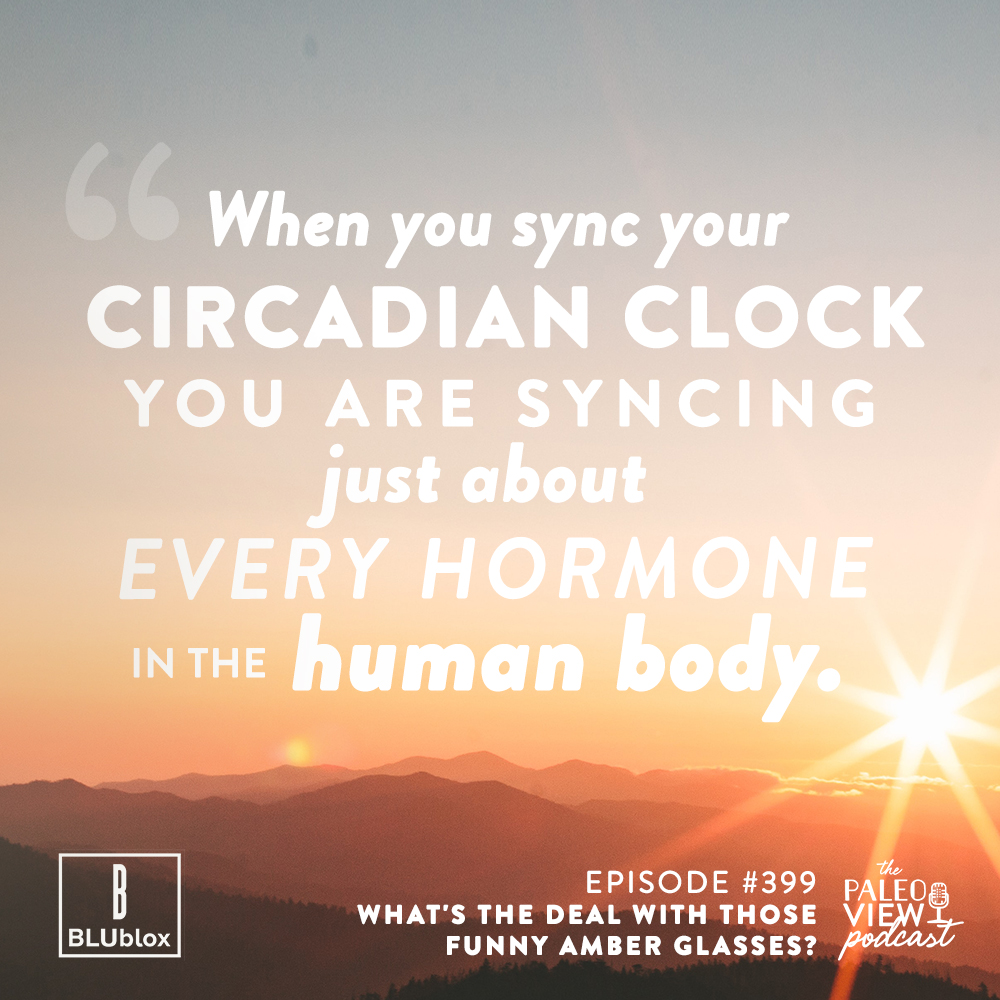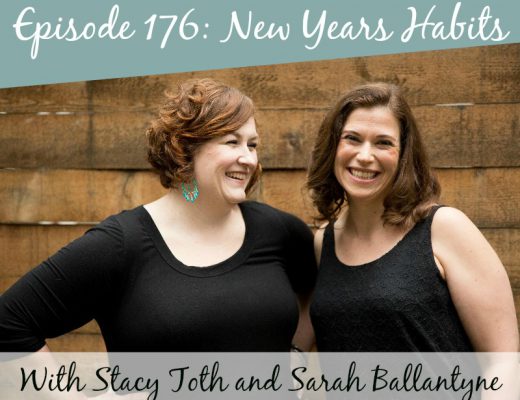
On this week’s episode, Stacy and Sarah discuss the use of blue-blocking glasses, also known as amber-tinted glasses. Sarah broke down the research that shows the ways we can impact our sleep quality and quantity, and Stacy shared her personal experience with the impact blue-light blocking glasses have had on her routine. Tune in below!
If you enjoy the show, please review it on iTunes!
The Paleo View (TPV), Episode 399: What’s the deal with those funny amber glasses?
Welcome to episode 399 of the Paleo View. (0:40)
Stacy and Sarah might have a giant announcement to share in episode 400.
You might have to tune-in.
Stacy feels like it has been a long time coming.
Right before hitting record, Stacy and Sarah were talking about life.
Life is still interesting if you are listening during a different time.
Stacy is in week-four of social distancing and her emotional rollercoaster is still continuing to happen.
Sarah noted that this is the new normal as we are all adapting and adjusting.
Stacy has lots of blue-light blocking glasses, and she does feel a difference in her eye-fatigue when she wears them.
Despite how often they have discussed the importance of amber-tinted glasses, Stacy thought that the cool versions were the same as the regular amber-tinted lenses.
Sarah noted that there are multiple kinds of blue, which she will cover in greater detail in the show.
Stacy initiated melatonin production recently and then elevated her cortisol from a conversation, and she feels like something got messed up with her sleep cycle as a result.
Sarah is going to address what happened to Stacy in her notes on this week’s show.
She realizes that she has never gone deep into the science on amber-tinted glasses.
This is a great episode to take a step back and talk about circadian rhythm, the light-dark cycle, and the magnitude of the effect of light exposure timing has on sleep.
Sarah is currently focusing on dialing in the lifestyle factors that are easy to let slide when she gets busy.
Let’s take a step back and talk about why these funny looking amber-tinted glasses work, which will make it clear how they can impact your sleep.
BLUblox
First, this week’s sponsor BLUblox, Stacy and Sarah want to give a special shoutout. (12:55)
Stacy loves that they donate a pair of reading glasses to someone in a developing world for each pair of BLUblox that they sell.
Especially right now, Stacy loves supporting companies that give back.
Sarah noted that they make really high-quality blue-blocking glasses, and how you can tell the difference between low-quality brands.
You can actually still see really clearly with them on, even at night.
BLUblox is creating such high-quality optic grade lenses, and it is a super-specific tint.
Their glasses are made in Australia.
Stacy noted that they really do create a calming, sedative state.
To check them out visit this site.
And if you purchase a pair, enter the code ‘PALEOVIEW’ for 15% off.
Circadian Rhythm
In order to understand the benefits of wearing blue-block glasses in the evening, Sarah wants to take a step back to explain circadian rhythm. (16:52)
The term circadian rhythm refers to the fact that a huge array of biological processes cycle according to a 24-hour clock.
Circadian rhythm allows your body to assign functions based on the time of day (and whether or not you are asleep).
For example, prioritizing tissue repair while you are sleeping, and prioritizing the search for food, metabolism, and movement while you are awake.
Your brain has a master clock, called the circadian clock, which is controlled by specialized cells in a region of the brain called the suprachiasmatic nucleus of the hypothalamus.
Clock genes are components of the circadian clock comparable to the cogwheels of a mechanical watch.
They interact with each other in an intricate manner generating oscillations of gene expression.
Clock genes are components of the circadian clock comparable to the cogwheels of a mechanical watch. They interact with each other in an intricate manner generating oscillations of gene expression.
The SCN receives information about illumination through the eyes.
The retina contains specialized ganglion cells that are directly photosensitive (contain the photopigment melanopsin), and project directly to the SCN (via a pathway called the retinohypothalamic tract), where they help in the entrainment of the master circadian clock.
The Circadian Clock
The circadian clock actively gates sleep and wakefulness to occur in synchrony with the light-dark cycles.
It shuts off melatonin production and boosts cortisol secretion and heart rate 2-3h prior to waking.
The circadian clock then controls the ebb and flow of certain hormones (cortisol and melatonin being especially important), which act as signals of the circadian clock throughout the body.
Cortisol peaks shortly after waking, and melatonin peaks during the middle of the night.
Secretion of melatonin peaks at night and ebbs during the day and its presence provides information about night-length.
Because the master circadian clock in our brain is set by light and dark, it is important to understand that indoor light is not bright enough to be the daytime signal.
And it is too bright to be the get ready for bed signal.
Indoor light is the worst of both worlds.
It is interesting to look at the luxe values of different types of light.
Brightness is a huge part of this.
If we spend all of our days indoors, it isn’t bright enough to impact our circadian clock.
And it is too bright to use it in the evening to tell our body it is nighttime.
It turns out that blue wavelengths of light are the most important for syncing that circadian clock.
Which means that bright blue length waves of light during the day tell our body what time it is.
Daylight is rich in blue light.
Sunrise and sunset have very little blue light and has a lot of red light.
LED bulbs, in particular, have a very high output in blue wavelengths.
However, these wavelengths aren’t high enough to mimic daylight.
Dim Light Melatonin Onset
We have this thing called Dim Light Melatonin Onset (DLMO). (29:22)
It turns out that light is an inhibitor of DLMO.
A substantial number of studies have shown that the onset of melatonin secretion under dim light conditions (DLMO) is the single most accurate marker for assessing the circadian pacemaker.
Light, especially blue wavelengths, suppresses melatonin production in the evenings, called light-induced melatonin suppression.
There have been a bunch of studies that have looked at what happens when you basically mess up this natural ebb and flow.
We know that blue wavelengths of light in the evening suppresses that normal melatonin production, and that is a direct contributor to sleep disturbances.
Stacy shared how they focus on using warm-lighting in the evenings.
Solutions
One of the ways to biohack this dim light signal that we need in the evenings is to use red lightbulbs and use a dim setter.
Programable LEDs are another great option.
However, this also means you have to avoid screen exposure, which is a challenging thing to do.
In an ideal world, you would avoid screen exposure for two to three hours before bed.
This is why wearing amber glasses is a much more accessible solution, which allows us to use our devices.
Sarah covered training your circadian clock with your sleep/wake cycle if you work night shifts.
There is essentially a three-part solution to work with here.
We want to first get that bright light exposure during the day of at least 10,000 luxe.
The easiest way to do that is to go outside at some point during the day.
An alternative is to use a 1o,000 to 12,000 luxe light therapy lamp or box.
The big thing to address in cementing this light/dark cycle is the two-hours of no blue light before bed.
The next thing is sleeping in a really dark room.
The third piece is to enforce a consistent schedule with this.
If you lost your light/dark cycle, your circadian clock will continue to chug away at about 24-hours for a while before it starts to get messed up.
Additional Bio-Hacks
It is also important to put on your blue-light blocking glasses at the same time every night.
This information came from a study that was done on Seasonal Affective Disorder.
Even in bright-light conditions, the impact on sleep is considered a relatively small effect.
There is this other big challenge that there hasn’t been enough research to optimize timing for light therapy.
Sarah shared on what research has been done to date on light therapy lamps and what the science shows in terms of gaps in information.
It doesn’t matter when you are getting outside for daylight exposure.
However, there really isn’t enough to know, if you are looking to optimize sleep, what is the best way to do it.
When it comes to optimizing sleep, blue-blocking glasses is where it is at.
Stacy reiterated that if you thought you had blue-light-blocking glasses and were doing great, know that you are not alone.
Stacy and Sarah talked about melatonin on this podcast episode.
When you sync your circadian clock, you are synching just about every hormone in the human body.
While most studies are measuring melatonin, it is impacting much more.
Stacy is not a big fan of supplementing unnecessarily.
It has been something that they have used for Wesley when needed.
However, Stacy is going to get him his own pair of amber-tinted glasses and see how that helps.
Sarah’s 13-year-old resists wearing them.
Stacy uses the angle of trying new things as a science experiment to get buy-in from her boys.
Literature Review
One of the things that Sarah wants to emphasize is that there isn’t enough data yet that a metanalysis has been done on blue-light blockers. (51:26)
This implies that we don’t necessarily have a definitive answer on the magnitude of the effect.
Sarah is going to go through the studies.
However, please keep in mind that the true magnitude of the effect is probably an average of all these different types of studies.
Sarah wanted to illustrate the different scenarios in which blue-blocking glasses have been shown to benefit sleep.
The scientific evidence right now is that no one would be exempt from benefiting from them.
Orange-lenses (also called amber lenses) cut the specific blue portion of light.
Sarah explained the difference between the different kinds of lenses that are available.
The first study that was published in 2006 took 14 healthy, normal people.
They exposed these people to a bright light for an hour at 1:00 a.m.
The participants wore either orange lense glasses or gray lens glasses.
Those blue-blocking glasses let in 20% more light, and these people had a 6% increase in melatonin compared to no light exposure the day before.
The people wearing gray glasses had a 46% reduction in melatonin.
It nearly cut their melatonin in half.
From there, blue-light blocking glasses started to be tested on different populations.
A Look at More of the Science
The next study done in 2009, looked at 20 volunteers, again normal – healthy adults.
This study looked at whether or not wearing proper blue-blocking glasses or yellow-tint glasses had the biggest impact.
The study found that the group of people who were wearing blue-blocking glasses had huge improvements in sleep quality, relative to the people who were blocking ultra-violet light.
This study also measured mood, which is significantly impacted by our sleep quality.
The study found that the people wearing amber glasses had much higher mood scores the next day.
One of the things that researchers have looked at with amber glasses (in a 2010 study) is shift workers who altered their light/dark cycle to match their workday, even though it doesn’t match what is going on outside.
Sarah broke down the details on how the study was conducted.
The study found that those shift workers at the sawmill who were doing all these controlling measures of their light had much-improved sleep.
They also had improved job performance, measuring errors.
Additional Elements of Testing
There was a study published in 2015 looking at the impact on adolescents.
Adolescents have a natural delay in their sleep cycles.
This study took 15 to 17-year-old young men, who were healthy, and had them wear blue-light blocking glasses in the evening.
They looked at how these glasses impacted sleep parameters.
The study showed that wearing blue-blocking glasses improved their dim light melatonin production.
It normalized their sleep patterns.
Around the same time, a study was done in delayed sleep phase disorder.
These patients wore blue-light blocking amber glasses from 9:00 p.m. until bedtime for two weeks.
The amber glasses reduced the amount of time it took to fall asleep by 132 minutes.
It reduced how long it was taking them to fall asleep by 72 minutes.
A 2019 study done in recreational athletes looked at recovery and the correlation with sleep quality.
The study looked at young, healthy, recreational athletes.
They either had no light restriction or wore amber glasses in the evening.
It showed that their sleep quality improved and the time it took them to fall asleep dropped from 19 minutes to 12 minutes.
They also had measured increased alertness the following morning.
There have been studies looking at psychological disorders, in particular manic states associated with bipolar disease.
They had these study participants wear blue-light blocking glasses from 6:00 p.m. to 8:00 a.m.
The results showed much better sleep efficiency, much fewer nights of interrupted sleep, and required less pharmacological treatment for sleep.
The Study With Multiple Elements
The last study Sarah wants to talk about was done in professional athletes.
This study added a strict schedule and light therapy to the mix.
They wore glasses that replaced a light therapy box in the morning.
And they wore amber glasses in the evening.
They were then told to sleep on a regular schedule and to go to bed at a specific time.
The study found there were a lot of study participants that didn’t want to do the schedule part.
They did everything else, expect the consistent schedule.
The researchers ended up dividing that into two groups.
In the people who did it as a consistent schedule, they had much stronger effects.
Their time to go to sleep went down by 17 minutes, as opposed to the other group’s 8 minutes.
They had a much more obvious improvement in sleep quality.
This last study puts a bow on this entire conversation.
Closing Thoughts
One of the best things we can do to support sleep is to tell our circadian clock what time of day it is by regulating the light/dark cycle. (1:08:48)
And to replicate it with bio-hacks as appropriate.
Adding in a consistent schedule is really important.
Sarah broke this ‘why’ down further.
Stacy thinks this information will be very helpful for her family.
She loves that this information is backed by science and doesn’t require supplementation.
Stacy appreciates Sarah pulling all this science together.
A big thank you to this week’s sponsor, BLUblox glasses.
Don’t forget, to check them out visit this site.
And if you purchase a pair, enter the code ‘PALEOVIEW’ for 15% off.
They offer all kinds of solutions for whatever it is you are looking for.
Prescription lenses are also a custom setting option.
Don’t forget, Stacy and Sarah will be back again next week with a big announcement!
They are so excited to share the news, as they have been working on this for a long time.
Thanks for listening (1:14:22)





